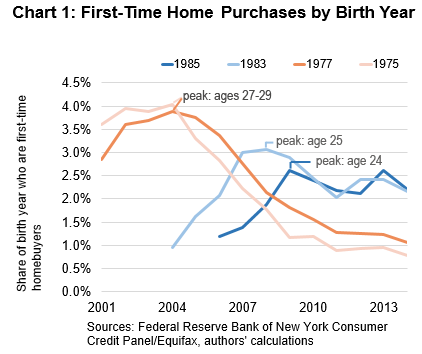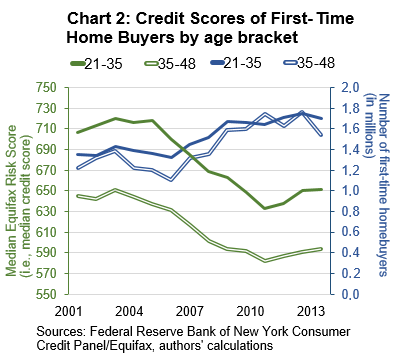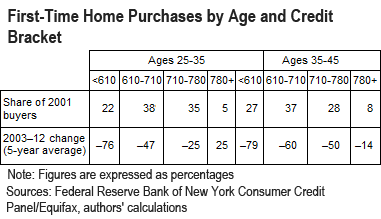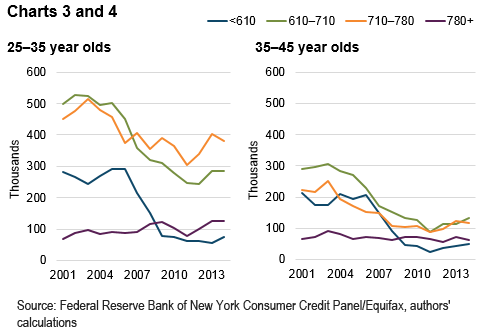Recall that, in our last post, we investigated the claim that millennials were to blame for the decline in first-time home purchases. Our data analysis confirmed that home purchases by first-time buyers have indeed plummeted since the crisis. We did not, however, find evidence that millennials were driving this decline. We found that, if anything, first-time homebuyers have become younger since the crisis, not older. By contrast, location appeared to be a much stronger predictor of declines in first-time buying than age.
Notwithstanding, many commentators still believe that millennials are behind sluggish sales. In this post, we take a closer look at the timing of first-time home purchases and the credit trends of first-time homebuyers with an eye towards the changing composition of homebuyers. We use the same credit bureau data set that we used in the previous post (take a look for a description of the data and our definition of first-time homebuyer). Using this data, we dig a bit deeper into two theories that are often cited for why millennial homebuyers are not buying as many homes as in the past. We first analyze whether millennials delayed the purchase of their first home in response to the crisis. Then we investigate what role, if any, credit tightening has played.
In short, we can't confirm any delay in the timing of home purchases. What we do find is that the distribution of first-time home purchases changed after the crisis. First-time home purchases by younger buyers peak earlier and persist at an elevated level over a longer period of time than before. We also find, contrary to the popular theory that credit became too tight for millennials to buy homes, that mortgage credit actually became tighter for older first-time buyers than for younger first-time buyers. Taken together, we think these data observations help to explain why the median age of the first-time buyer shifted downwards (instead of upwards) after the housing downturn.
Timing
To examine how the housing downturn affected the timing of purchases by young first-time homebuyers, we separated this group out by birth year and examined the number of home purchases from 2000 to 2014. We looked at millennial homebuyers born in 1983 and 1985 and compared them to Gen X homebuyers born in 1975 and 1977.
Chart 1 shows the number of first-time home purchases for each year, with each line representing a different birth year. The time series for the older birth years peaks between the ages of 27 and 29 while the time series for the younger birth years peaks between the ages of 24 and 25. For Gen Xers who came of age before the crash, their peak appears to be the culmination of a steep increase in purchases and an almost equally steep decline resulting in a curve that looks roughly like an inverted V. For the millennial birth years, who came of age after the real estate crash, the peak in first-time purchases occurs earlier and the decline of the curve is much more gradual. The change in the distribution of purchases after the crash suggests that the younger first-time home buyers are still purchasing homes at relatively high rates, but purchases are spread out over a wider time period.
The distribution of millennial first-time homebuyers has clearly shifted. Not only has the distribution of first-time homebuyers become younger over time (refer to previous post) but first-time home buying among the most recent birth years is peaking at an earlier age. Why might this be? We think a closer look at credit trends can shed some light on this question.
Credit scores
In Chart 2, we examine the number of first-time home purchases and median credit scores of first-time home purchasers by age bracket. The two age brackets are adults under 35 years old and adults between the ages of 35 and 48. By grouping first-time home purchases into age brackets, we are able to examine whether credit is tighter for younger borrowers than for older borrowers using the median Equifax risk score as a proxy for credit tightness.1
From 2001 to 2014, median FICO scores increased by 5.0 percent for the younger group and 5.1 percent for the older group. In general, the median credit scores of both groups appear to behave similarly, except during the years when subprime lending prevailed. The median credit scores for both younger and older buyers shifted down between 2003 and 2006, signaling that there were more purchases by higher-risk buyers. With that said, the decline in the median credit score was more pronounced for older buyers (down 4.1 percent, from 689 in 2003 to 661 in 2006) than for younger buyers (down just 1.6 percent, from 693 in 2003 to 682 in 2006). Since the crisis, the gap between the median credit scores of younger and older buyers has closed (in other words, credit has become tighter for older buyers), which may explain why first-time home purchases have fallen faster for older buyers than it has for younger buyers. Indeed, between 2001 and 2014, first-time home purchases fell by 36 percent for younger homebuyers and by 54 percent for older buyers.
The table and Charts 3 and 4, below, delve deeper into the credit trends of younger and older first-time homebuyers, showing home purchases by credit bracket, year, and age. We determined credit brackets by taking the quartiles of every individual with a credit record in the time period. As the charts show, purchases by those with the lowest credit scores, marked in blue, have plummeted steeply. Credit scores in the middle, marked in green and orange, fell sharply, too, but particularly among older buyers. Older first-time homebuyers with moderate credit scores were much less likely to buy homes after than before the crisis, falling by 50 to 60 percent. Purchases by those with stellar credit, marked in purple, were barely affected by the crisis. Perhaps a more interesting observation is that young homebuyers in the highest credit bracket were the one subgroup to increase their purchases during and after the recession. First-time purchases by this group of young buyers actually rose by 25 percent.
We believe this collection of charts demonstrates in more detail that credit became tighter for older homebuyers during the crisis—and also that an uptick in home purchases by the most creditworthy millennials has buoyed purchases for that age bracket.
The Federal Reserve Bank of New York Consumer Credit Panel/Equifax data is an unusual data set in that it allows us to compare first-time homebuyers without first conditioning by age. By comparing older and younger first-time homebuyers, we have been able to examine the claim that millennial homebuyers are behind the stagnation in home sales. In addition to our earlier findings that first-time buyers have become younger, not older, since the crisis, we find that the distribution of first-time home purchases has changed since the housing downturn. Specifically, first-time purchases by younger buyers tend to peak at an earlier age and persist at an elevated level over a longer period of time. This is in contrast to the trend before the downturn, when first-time purchases by younger buyers peaked at an older age and dropped off precipitously after peaking. Moreover, the data reveal that, while younger and older first-time buyers have similar credit trends when tracked as the median credit score, credit may have loosened more for older first-time buyers than younger first-time homebuyers during the run-up and as a consequence tightened more for older buyers than younger buyers during the recovery, resulting in a lower number of first-time purchases by this older group. Despite the fact that many believe tight mortgage credit, student loan debt burdens, and stagnating wages have made it more difficult for millennials to buy homes, it appears that credit tightness has actually weighed more heavily on older first-time homebuyers.
 By Elora Raymond, graduate research assistant, Center for Real Estate Analytics in the Atlanta Fed's research department, and doctoral student, School of City and Regional Planning at the Georgia Institute of Technology, and
By Elora Raymond, graduate research assistant, Center for Real Estate Analytics in the Atlanta Fed's research department, and doctoral student, School of City and Regional Planning at the Georgia Institute of Technology, and
 Jessica Dill, economic policy analysis specialist in the Atlanta Fed's research department
Jessica Dill, economic policy analysis specialist in the Atlanta Fed's research department
_______________________________________
1 Examining credit scores over time can be misleading. Credit scores measure a person's ranking of creditworthiness at a given time. A credit score does not give an absolute measure of someone's default probability, just where they are relative to others. So, someone with a 700 credit score in one time period may have a different default probability than someone in another time period, though their rank relative to others remains the same. This becomes relevant if the creditworthiness of the American public as a whole shifts dramatically over time






